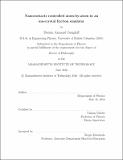Nanocontacts controlled atom-by-atom in an ion-crystal friction emulator
Author(s)
Gangloff, Dorian Armand
DownloadFull printable version (12.95Mb)
Other Contributors
Massachusetts Institute of Technology. Department of Physics.
Advisor
Vladan Vuletić.
Terms of use
Metadata
Show full item recordAbstract
Friction is the basic, ubiquitous mechanical interaction between two surfaces that results in resistance to motion and energy dissipation. To test long-standing atomistic models of friction processes at the nanoscale, we implemented a synthetic nanofriction interface between a laser-cooled Coulomb crystal of individually addressable ions as the moving object and a periodic light-field potential as the substrate. Through a variety of experiments presented in this thesis, we show atom-by-atom and with high spatial resolution that friction at the nanoscale can substantially differ from the simple phenomenological laws observed at the macroscale. Namely, we show that atomic-scale stick-slip friction can be tuned from maximal to nearly frictionless via arrangement of the ions relative to the periodic potential, and study the associated transition in transport dynamics as manifested by the propagation of kinks. We show that friction depends on velocity and temperature, in excellent agreement with simple analytical models, and that in the appropriate velocity regime, the dynamics can be observed in a way that is effectively at zero-temperature. We also establish a direct link between Aubry's structural transition for an infinite chain in an incommensurate periodic potential, and the vanishing of friction in nanocontacts. Our model system enables a microscopic and systematic investigation of friction, potentially even into the quantum many-body regime.
Description
Thesis: Ph. D., Massachusetts Institute of Technology, Department of Physics, 2016. This electronic version was submitted by the student author. The certified thesis is available in the Institute Archives and Special Collections. Cataloged from student-submitted PDF version of thesis. Includes bibliographical references (pages 187-200).
Date issued
2016Department
Massachusetts Institute of Technology. Department of PhysicsPublisher
Massachusetts Institute of Technology
Keywords
Physics.